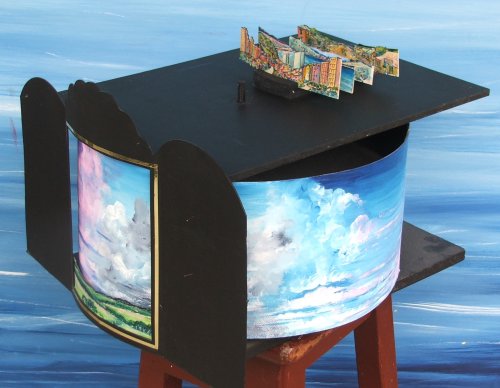Many names have been applied to this object but essentially it is a painted drum moving through a viewing area that is cut out at the front like a proscenium (classic) stage that has an image placed in a special holding device at the bottom to give it scale and placement. The ‘frame’ or ‘box’ that forms the support is 510mm (20”) wide and the depth is exactly the same. The overall height is approx. 305 mm (12”) The rotating drum is balanced on a wooden spindle and has 7 main images painted of the sky for various times of the day and year. The viewing area at the front is 230mm high x 180mm wide (9” X 7”)
From left to right the main images in ONE revolution of the sky (the drum spins slowly) comprise -:
(1) Sunrise (2) Wet Day (3) Fine Day Cloudy (4) Fine Day Clear with higher clouds (5) Afternoon (6) LATE Afternoon (Pink Glow) and (7) Sunset. Then it begins over again.
Now between each of these 7 original images are a further 7 transitional images with ‘mixed’ parts of each image depending on where you spin it to. So it is possible to state that there are probably at least 14 different sky images that can be ‘dialled’ up. Some mathematicians would argue there are more for how do you ‘measure’ a changed area. I opt for a 50% change! So a slight variation right would be .5 and V.V. slightly back to the left it would be -.5. ’… In great works of Art there be great Mathematics’….
At the base of the viewing area there is provision for the attachment of inserts that provide a foreground to the sky behind. At present there are 5 of these -: (A) CITY SCAPE (B) COUNTRY HILLS (C) COUNTRY TOWN (D) SEASCAPE (E) COUNTRY ROAD. So immediately this small machine would be able to show 5 X 14 = 70 composite scenes. BUT wait there’s more!
An added Feature is that 2 inserts are able to be placed at the front of the image – e.g. City Scape IN FRONT OF the Seascape, or the Country Hills IN FRONT of the City etc. So this effectively doubles the number of available images to 140!
Overall the area of painted images of sky PLUS the inserts is equivalent to a painting approx. 712mm X 460mm or a little under 28” X 18”. And all this from such a small viewing area”
Originally the viewing area for this ‘machine’ was going to be a ‘stock’ size (see faqs) of 24” X 18” (610mmX 460mm) To my horror I calculated I would have had to build an extra room onto the house just to house this one exhibit.
Curiously an American friend explained that this was a ‘Zoetrope’. On further investigation I have deduced that although it has some of the characteristics of these early movie machines it IS completely different. In a Zoetrope various ‘STATIC’ images are placed INSIDE a drum and through a VERY NARROW slit when it is spun the images appear to move – a bit like flipping through a pile of cards with static images where the image appears to move.
I hope you find it as enjoyable as some of my students once did.
